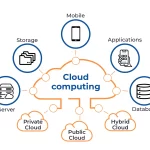Cloud Computing: Benefits and Challenges
Benefits of Cloud Computing Cost Efficiency: Cloud computing eliminates the need for upfront capital investments in hardware and infrastructure. Businesses can leverage pay-as-you-go models, where they pay only for the resources they use. This flexibility enables cost optimization, especially for small and medium-sized enterprises that may have limited budgets. Scalability and Elasticity: Cloud computing provides virtually limitless scalability, allowing businesses to scale up or down their resources based on demand. Whether it’s a sudden surge in website traffic or increased computational requirements, the cloud offers the ability to rapidly adjust resource allocation, ensuring optimal performance without costly hardware upgrades. Reliability and Availability: Cloud service providers employ redundant infrastructure and data centers, reducing the risk of downtime. Service level agreements (SLAs) guarantee high availability, ensuring that critical applications and data are accessible at all times. Moreover, data replication and backup mechanisms provided by cloud vendors enhance data protection and disaster recovery capabilities. Global Accessibility and Collaboration: Cloud computing enables access to applications and data from anywhere with an internet connection. This promotes remote work, facilitates collaboration among geographically dispersed teams, and improves productivity. Additionally, cloud-based collaboration tools allow real-time sharing and editing of documents, fostering efficient teamwork. Enhanced Security: Cloud service providers invest heavily in security measures, often offering more robust security infrastructure than what most organizations can afford on their own. They implement strict access controls, encryption, and continuous monitoring to protect data from unauthorized access, breaches, and data loss. Moreover, cloud providers undergo regular security audits and certifications to maintain compliance with industry standards. Challenges of Cloud Computing Data Security and Privacy: While cloud providers implement strong security measures, concerns regarding data security and privacy persist. Organizations must thoroughly evaluate the security practices and compliance standards of cloud vendors, especially when dealing with sensitive data. Encryption, access controls, and data segregation techniques should be implemented to mitigate risks. Vendor Lock-In: Migrating applications and data to the cloud can create dependencies on specific vendors. Switching between providers or bringing data back in-house can be challenging and costly. Organizations should carefully consider interoperability and data portability when selecting a cloud provider to avoid vendor lock-in. Downtime and Reliability: Despite high availability guarantees, cloud services may experience occasional outages or disruptions. Organizations must carefully assess the SLAs offered by providers and understand the potential impact of downtime on their operations. Developing contingency plans and considering multi-cloud or hybrid cloud strategies can minimize risks associated with service disruptions. Compliance and Legal Issues: Organizations operating in regulated industries must navigate compliance requirements, such as data sovereignty, industry-specific regulations, and cross-border data transfer restrictions. Cloud users should ensure that their chosen provider complies with relevant standards and can meet their compliance obligations. Network Connectivity and Performance: Cloud computing heavily relies on internet connectivity. Inadequate bandwidth, network latency, or unreliable connections can impact application performance and user experience. Organizations must assess their network infrastructure and consider redundancy options to ensure reliable connectivity. Conclusion Cloud computing offers a wide array of benefits, including cost efficiency, scalability, and global accessibility. By leveraging cloud services, businesses can focus on innovation, agility, and rapid growth. However, challenges related to security, vendor lock-in, downtime, compliance


































